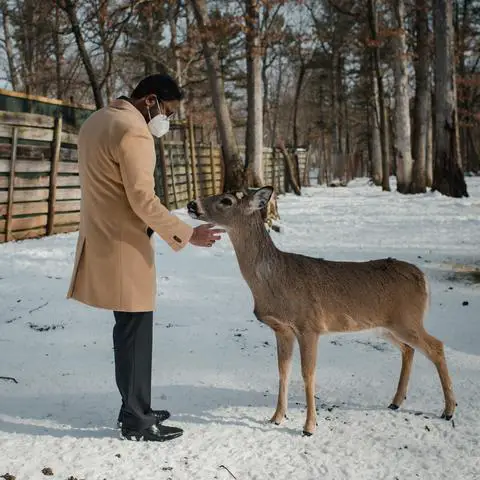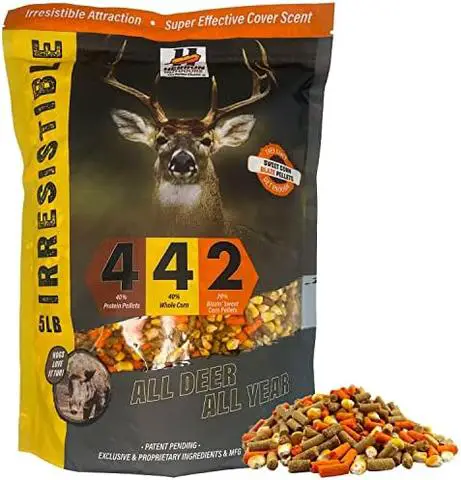“But at my age” – Embracing Life’s Adventures and Pursuits with Wisdom and Experience
Alternative Feeding Options for White Tail Deer: Considering Age and Convenience

Alternative Feeding Options for White Tail Deer: Considering Age and Convenience
Feeding White Tail deer can be a rewarding experience, but it’s important to consider alternative options that are suitable for the deer and convenient for you, especially if you have physical limitations or find it difficult to handle heavy bags of feed.
One option to consider is providing a mix of high-quality grains such as oats, barley, or wheat. These grains can be purchased in smaller 40 lb bags, which may be more manageable for you. Grains provide energy and nutrients that can supplement the deer’s diet.
In addition to grains, you might also consider including some protein-rich feed in their diet. Alfalfa pellets or soybeans are good sources of protein that can help support the deer’s growth and overall health. These protein-rich feeds can also be purchased in smaller bags for your convenience.
It’s important to ensure that any feed you provide is appropriate for deer and does not contain additives that could be harmful to them. Read the labels carefully and choose feeds specifically formulated for wild animals or consult with local wildlife or conservation authorities for guidance on suitable feed options.
While feeding deer can be a rewarding experience, it’s important to note that encouraging them to stay around populated areas by providing food is generally not recommended. Feeding wild animals can lead to dependence on human-provided food, which can result in unintended consequences such as damage to property or even harm to people.
In conclusion, when considering alternative feeding options for White Tail deer, it’s important to choose suitable feeds such as high-quality grains and protein-rich options like alfalfa pellets or soybeans. Ensure the feeds are appropriate for deer and do not contain harmful additives. However, it is generally advised against feeding wild animals regularly as it may lead to negative consequences.
Lighter Alternatives to Whole Corn for Feeding White Tail Deer

Lighter Alternatives to Whole Corn for Feeding White Tail Deer:
1. High-Quality Grains: Instead of whole corn, you can provide a mix of high-quality grains like oats, barley, or wheat. These grains are lighter in weight and can still provide the necessary nutrients for the deer.
2. Protein-Rich Feed: Along with grains, consider adding some protein-rich feed to their diet. Options like alfalfa pellets or soybeans can be beneficial for the deer’s overall health and growth.
3. Consulting Local Authorities: It’s important to ensure that any feed you provide is suitable for deer and does not contain harmful additives. Consulting with local wildlife or conservation authorities can provide valuable insights into the best feeding practices for the deer in your area.
4. Avoid Encouraging Dependency: While it may be tempting to feed wild animals, including deer, it is generally not recommended as it can lead to dependency and potential harm to both animals and humans. Feeding wild animals can cause them to become expectant of food from anyone and everyone, leading to potential damage to property and even injuries.
5. Consider Natural Foraging: Instead of providing alternative feeds, allowing the deer to naturally forage for their food is often the best option. Deer typically consume a variety of plants such as grasses, leaves, fruits, and nuts. By preserving their natural habitat and providing a diverse range of vegetation, you can support their dietary needs without relying on artificial feeds.
Remember to prioritize the well-being of wildlife by promoting their natural behaviors and habitats rather than encouraging dependency through feeding.
Easier Feeding Solutions for Aging Individuals: White Tail Deer Feed Options

As an aging individual, it can be challenging to handle heavy bags of feed for White Tail deer. Fortunately, there are alternative options that can make feeding easier for you. One option is to use livestock feed in 40 lb bags instead of the 50 lb bags of whole corn. This can help reduce the weight you need to handle while still providing food for the deer.
Another convenient solution is to repurpose cat litter buckets for storing and dispensing the deer’s feed. After using up the cat litter, clean out the bucket thoroughly and use it to hold the corn or other feed. These buckets typically weigh about 20 pounds when filled with corn, making them easier to manage compared to larger bags.
The flip-top lid on the cat litter buckets helps seal in the freshness and keep the kernels dry. Additionally, these buckets are stackable, allowing you to save storage space while keeping an adequate supply of feed for the deer.
If you don’t have any empty cat litter buckets available, consider asking friends or family members who have cats if they can spare a couple of buckets. This way, you can continue providing food for the White Tail deer without straining yourself.
By implementing these easier feeding solutions, you can continue supporting the deer’s nutritional needs while minimizing physical strain on yourself as an aging individual.
Convenient and Manageable Feeding Methods for White Tail Deer at an Older Age
As an AI language model, I can provide you with information on convenient and manageable feeding methods for White Tail deer at an older age.
1. Consider alternative feed options: While whole corn can be a suitable feed for deer, there are other options you can consider to make it more convenient for you. Deer typically consume a variety of plants, including grasses, leaves, fruits, and nuts. You might consider providing them with a mix of high-quality grains such as oats, barley, or wheat. These grains can be found in smaller bags compared to the 50 lb bags of corn that you mentioned.
2. Protein-rich feed: In addition to grains, you can also supplement their diet with protein-rich feed. This can include alfalfa pellets or soybeans, which provide essential nutrients for the deer’s health.
3. Ensure appropriate feed: It’s important to ensure that any feed you provide is appropriate for deer and does not contain additives that could be harmful to them. Avoid livestock feeds high in carbohydrates as they may not be suitable for deer.
4. Consult local wildlife or conservation authorities: Consulting with local wildlife or conservation authorities can provide valuable insights into the best feeding practices for the deer in your area. They may have specific recommendations based on the local habitat and dietary needs of White Tail deer.
Please note that while providing alternative feed options may be convenient for you, it’s important to keep in mind that feeding wild animals is generally discouraged due to potential negative impacts on their behavior and health. Feeding wild animals can lead to dependency and habituation towards human presence, which may result in unintended consequences such as property damage and harm to both humans and animals.
It’s always best to allow deer to fend for themselves as nature intended unless there are specific circumstances where intervention is necessary (e.g., severe winter conditions). If you have concerns about the welfare of the deer or their access to natural food sources, it’s recommended to consult with local wildlife authorities for appropriate guidance.
Adapting Deer Feeding Practices to Accommodate Age-Related Challenges

Adapting Deer Feeding Practices to Accommodate Age-Related Challenges
As we age, certain tasks can become more challenging, such as lifting heavy bags of feed for the deer. However, there are alternative feeding methods and practices that can help accommodate these age-related challenges.
One option is to consider using smaller bags of livestock feed. Instead of purchasing 50 lb bags, you can look for 40 lb bags or even smaller sizes that are easier for you to handle. This way, you can still provide feed for the White Tail deer without straining yourself.
Another solution is to repurpose containers that are lighter and more manageable. For example, if you have cats and use Tidy Cat litter, the empty buckets can be used to store the deer’s corn supply. These buckets are typically around 20 pounds when filled with corn and have a flip-top lid that seals down to keep the kernels dry. They also stack easily, saving storage space.
To acquire these buckets, you can ask your friends who have cats if they would be willing to give you a couple. This provides an easy solution that has been successfully utilized by many people. As someone who is pushing 70 years old, I have found this method to be convenient and practical.
By adapting your deer feeding practices in these ways, you can continue to provide nourishment for the White Tail deer while taking into account any age-related challenges you may face.
Age-Friendly Alternatives for Providing Nutritious Feed to White Tail Deer

Age-Friendly Alternatives for Providing Nutritious Feed to White Tail Deer
As you mentioned, feeding White Tail deer can be a challenging task, especially as the bags of feed become too heavy. However, there are age-friendly alternatives that can provide nutritious feed to the deer while minimizing physical strain.
One option is to consider using smaller bags of livestock feed. You mentioned seeing 40 lb bags of livestock feed, which could be a more manageable weight for you. When purchasing these bags, make sure to check the ingredients and ensure they are suitable for deer consumption. Look for high-quality grains such as oats, barley, or wheat in the feed mix.
Another alternative is to repurpose cat litter buckets for storing and providing corn feed to the deer. These buckets are typically made of sturdy plastic and have convenient flip-top lids that seal tightly, keeping the corn kernels dry. Each bucket filled with corn weighs about 20 pounds, making it easier to handle compared to larger bags. You can stack these buckets for efficient storage without taking up much space.
To acquire these cat litter buckets, ask around your friends who have cats if they would be willing to give you a couple of empty buckets after they finish using them for litter purposes. This provides an easy solution that has been tried and tested by many individuals.
It’s important to note that while providing alternative feeds can be helpful in certain situations, it’s generally recommended not to encourage wild animals like deer to become dependent on human-provided food. Feeding wildlife can lead them into populated areas where they may cause damage or pose risks to people and property.
In conclusion, considering age-friendly alternatives such as smaller bags of livestock feed or repurposing cat litter buckets can make it easier for you to provide nutritious feed to White Tail deer. However, it’s crucial to remember that encouraging wild animals’ dependence on human-provided food may have unintended consequences.
In conclusion, age should never limit one’s potential and aspirations. While there may be challenges associated with aging, it is possible to pursue personal growth, achieve new goals, and find fulfillment at any stage of life. By embracing a positive mindset, staying motivated, and seeking opportunities for learning and development, individuals can continue to thrive and make meaningful contributions to their own lives and society as a whole. Age should never be seen as a barrier, but rather as an opportunity for further self-discovery and achievement.











































